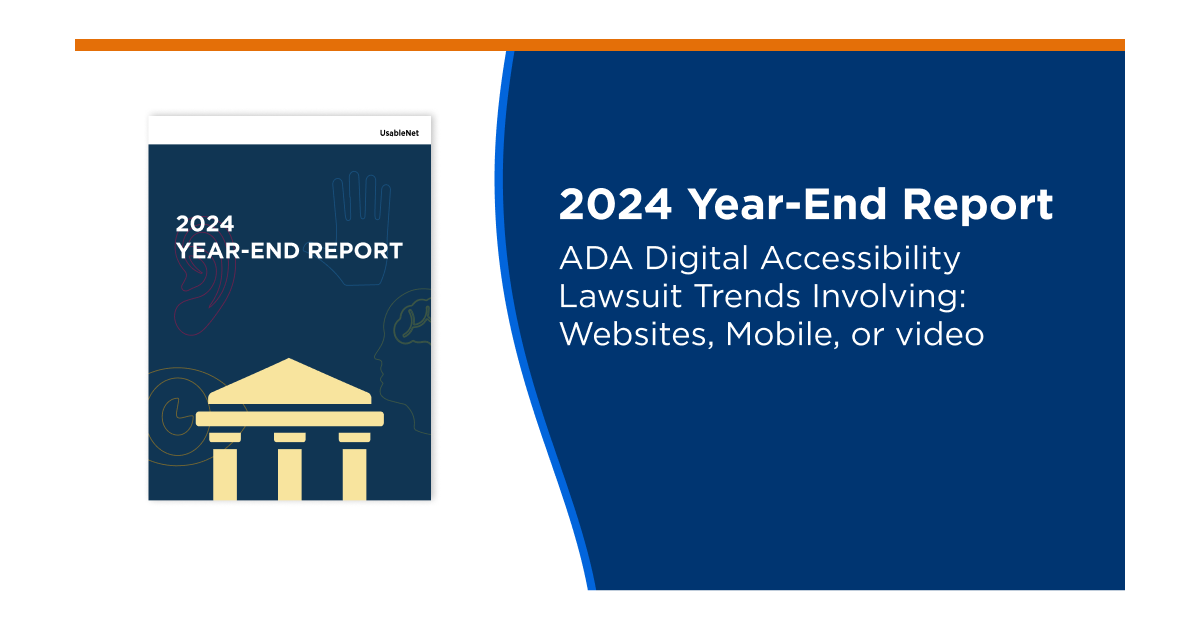We’re only a month into 2021, but it’s already clear that ADA digital accessibility lawsuits are unlikely to slow down as we move through the year.
Last year, we saw a big jump in ADA lawsuits surrounding digital accessibility with several emerging patterns and trends becoming more common.
In this post, we’re going to look at what you need to do about digital accessibility and ADA suits in 2021 based on our data from last year. (Editor's Note: This blog is a summary of our Jan 27th webinar, Digital Accessibility and ADA Lawsuits in 2021)
How We Got Our Data
Before we share our findings, we want to go over the methodology of how we compiled our 2020 ADA lawsuit report, which can be accessed here.
Here’s how we collected our data:
- Pacer for federal ADA lawsuits
- County court records for state suits
- We read all ADA dockets to find suits citing digital claims (last year there were around 2700 in federal court and around 700 in state courts)
- We don’t count legal actions alone like demand letters, as they’re too difficult to track, though they’re typically sent out about 3-4x as often as suits are filed
What Most ADA Digital Lawsuits Have In Common
While each individual ADA lawsuit is unique, there were solid trends that we saw consistently throughout 2020.
These are what about 80% of accessibility lawsuits had in common:
- Businesses in the eCommerce and Hospitality industries received the majority of claims
- Complaints were primarily made against websites or mobile apps
- A small number of plaintiffs (aka “compliance testers”) and a small group of plaintiff law firms brought most cases
- Most claims listed issues that are fast and easy to detect, like not having a screen reader-friendly site
- California, New York, and Florida were responsible for over 90% of cases when combining federal and state lawsuits
Factors Impacting the Rise in Cases
Last year, there was a 23% year-over-year rise in ADA lawsuits from the year before.
Here are the factors that impacted the rise in cases:
- DOJ continued to confirm their view that websites and apps are subject to the ADA, even with no technical standards set; they have joined over 200 cases over a 20 year period
- State laws like California’s Unruh act provide attractive plaintiff conditions like $4,000 damages
- Defendants typically settle, encouraging plaintiff firms
- Companies haven’t necessarily prioritized digital accessibility, so they often have issues that are easy to find and target
- Digital targets for plaintiffs are expanding; there were 10 video cases alone in one week this year, which is a distinct increase
- Accessibility widgets are popular but do not protect a site from a lawsuit
Predictions for 2021
Based on what we know about the current climate regarding ADA and accessibility lawsuits, we have a few solid predictions about what to potentially expect in 2021.
Vendors and web agencies are likely to be held accountable in ADA lawsuits.
The DOJ may become an active player in cases again under the new administration. There may also make some efforts to define technical accessibility standards as it relates to the ADA, instead of just relying on the unofficial WCAG 2.1 standard we have now. There may be some confusion or resistance around this, though, since WCAG 3.1 is due in two years.
What to Do if You Get a Lawsuit Claim or Demand Letter
If you receive a demand letter or are on the receiving end of a potential lawsuit citing an ADA violation, don’t panic. Take the following steps:
- Find counsel that has experience in ADA defense, specifically in the areas of digital accessibility
- Find a defense lawyer who knows the plaintiff's firm
- Contact your site vendor, agency, or technical team to understand what is happening
- Collect any documentation on completed accessibility efforts, remediation, or user testing performed
Experienced counsel will know the general options, strategies for defense, questions to ask, and unique litigation challenges surrounding ADA cases with digital accessibility as the core focus.
How to Scale Your Accessibility Efforts Now
Ready to make changes and revamp your digital accessibility this year?
The first thing you should do is to take stock of your public-facing digital channels and content, including your site, mobile apps, and video. Look for easy targets, like not being screen reader-friendly or lacking closed captions on videos.
Next, run automated accessibility tests on your ten most-frequented pages, including global elements and most-used components. See if you spot anything.
After you do this, have a blind user try to complete your top user tasks on all of your sites and apps. They’ll catch what automated tests miss.
Once you do this, complete a remediation plan, including the timeline and costs.
Once completed, test it again.
There’s a lot that goes into ensuring that your site is ADA-compliant for accessibility and liability-prevention purposes. We can help. Learn more about our full audits and manual tests here.
This blog post summarizes our recent webinar, Digital Accessibility and ADA Lawsuits in 2021.









